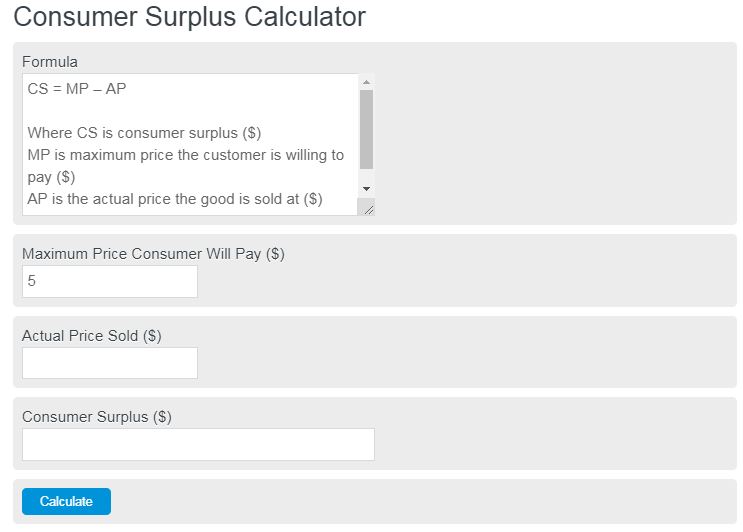Enter the maximum sale price of a good and the actual sale price into the calculator to determine the consumer surplus. This calculator can also determine the maximum consumer price and actual price given the other variables.
- Maximum Revenue Calculator
- Break Even Point Calculator
- Price Elasticity of Demand
- Producer Surplus Calculator
- Real Price Calculator
Consumer Surplus Formula
The following formula can be used to calculate a consumer surplus on a good.
CS = MP - AP
- Where CS is consumer surplus ($)
- MP is the maximum price the customer is willing to pay ($)
- AP is the actual price the good is sold at ($)
To calculate a consumer surplus, subtract the actual price of the good from the maximum price a consumer would buy the product at.
The maximum price the consumer is willing to pay is dependent on person to person, so it should be calculated using the average of the highest amount someone would be willing to pay.
Consumer Surplus Definition
The consumer surplus is defined as the difference between the maximum price a customer is willing to pay for a good and the actual price the good is sold at.
How to calculate a consumer surplus
The following example is a step by step guide on how to calculate a consumer surplus:
- The first step is to look at the equation above and determine which variables need to be known before we can calculate the consumer surplus. In this case, the max price the consumer is willing to pay and the actual price the item is sold at.
- Next, the maximum price a consumer is willing to pay must be determined. This can be done through analyzing data or through surveys of paying customers. For this example, we will assume that the maximum price is $1,000.00.
- Now we must determine the actual price the good is or will be sold at. Let’s assume this is an existing good and we have some data on its historical sale price. We will assume it is $200.00.
- Finally, enter the information into the formula to calculate the SC. CS = MP – AP = $1,000.00-$200.00 = $800.00.
- Analyze the results. As you can see a CS of 4 times the selling price is not a good result.
What is the maximum price a consumer will pay?
This is the million-dollar question that business owners ask every year. There are complicated formulas and entire fields of economics dedicated to studying how much consumers will pay for something. The easiest and quickest way is through the use of a survey. The more participants the more accurate the results will be. The participants should accurately reflect the people the good is trying to be sold to. If you are selling a high-end watch, you want to survey people of whether and vise versa for low-end products.
Setting the price of a good at the maximum is not always the best business decision. If the price is set at the highest possible point, it will sell very little volume. The best thing to do is to set a price where the volume and price equal the maximum revenue.

